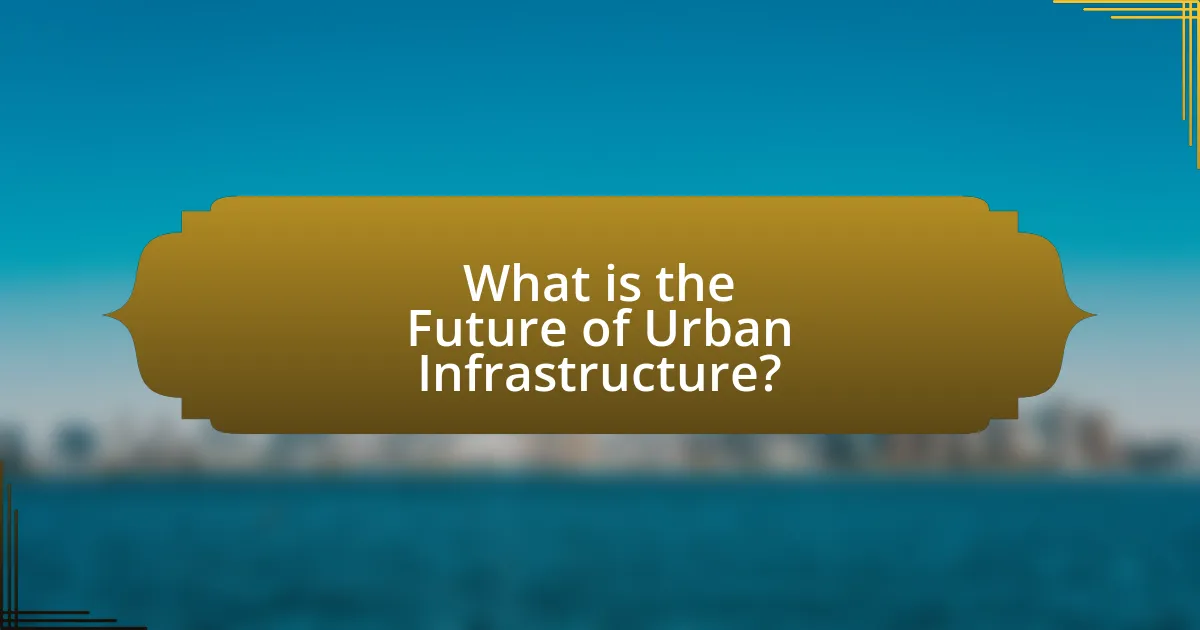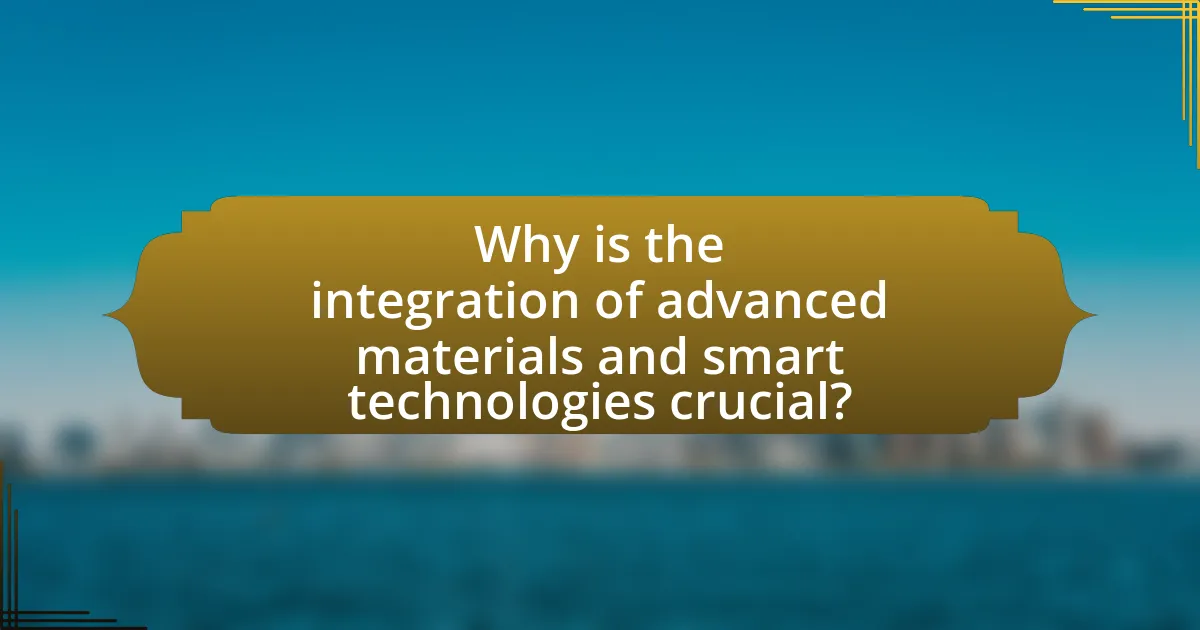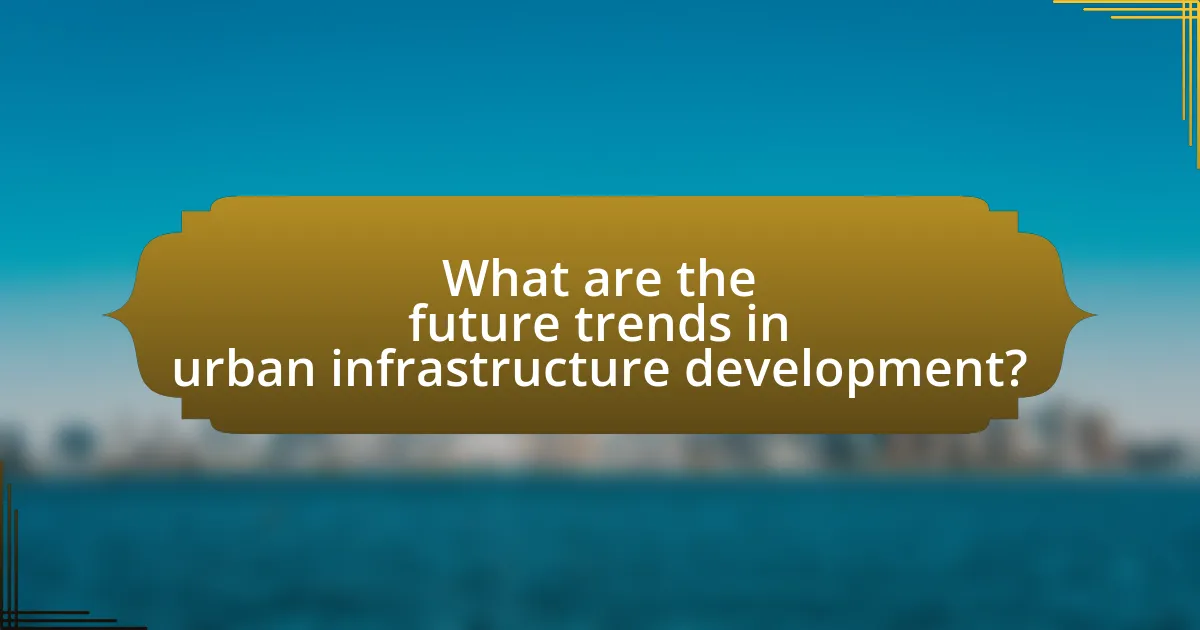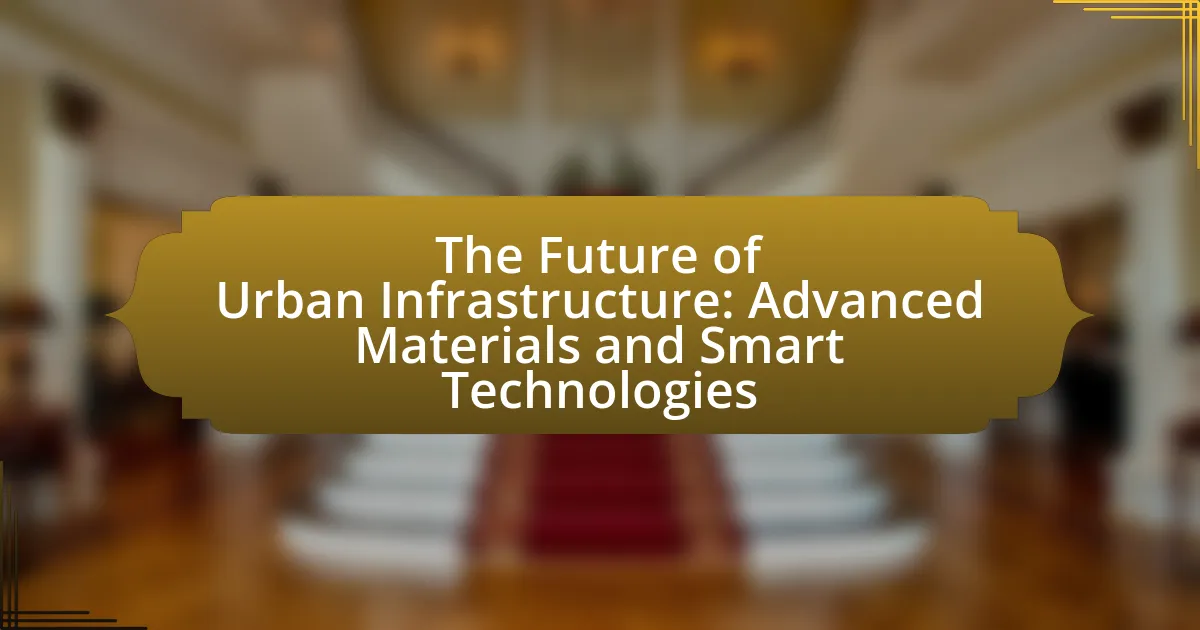The article focuses on the future of urban infrastructure, emphasizing the role of advanced materials and smart technologies in enhancing sustainability, efficiency, and resilience in urban environments. Key innovations discussed include self-healing concrete, smart sensors, and IoT devices, which collectively aim to reduce operational costs and environmental impact. The article also addresses the challenges cities face in adopting these technologies, such as financial constraints and public resistance, while highlighting the importance of community engagement and data-driven decision-making in successful implementation. Overall, it underscores the necessity for urban planners and policymakers to integrate these advancements to meet the demands of growing urban populations and climate change.

What is the Future of Urban Infrastructure?
The future of urban infrastructure will be characterized by the integration of advanced materials and smart technologies. These innovations aim to enhance sustainability, efficiency, and resilience in urban environments. For instance, the use of self-healing concrete and carbon capture materials can significantly reduce the carbon footprint of construction, while smart sensors and IoT devices enable real-time monitoring and management of urban systems. According to a report by McKinsey & Company, investments in smart infrastructure could lead to a 30% reduction in operational costs for cities by 2030. This shift towards intelligent and sustainable infrastructure is essential for accommodating growing urban populations and addressing climate change challenges.
How are advanced materials transforming urban infrastructure?
Advanced materials are transforming urban infrastructure by enhancing durability, sustainability, and efficiency in construction and maintenance. For instance, the use of self-healing concrete, which incorporates bacteria that produce limestone to fill cracks, significantly extends the lifespan of structures and reduces repair costs. Additionally, materials like carbon fiber-reinforced polymers offer high strength-to-weight ratios, allowing for lighter and more resilient designs in bridges and buildings. Research indicates that these innovations can lead to a reduction in overall material usage by up to 30%, contributing to more sustainable urban development. Furthermore, smart materials that respond to environmental changes, such as temperature or stress, enable real-time monitoring and maintenance, improving safety and reducing downtime in urban infrastructure systems.
What types of advanced materials are being utilized in urban settings?
Advanced materials utilized in urban settings include self-healing concrete, smart glass, and carbon fiber composites. Self-healing concrete contains bacteria that produce limestone to fill cracks, enhancing durability and reducing maintenance costs. Smart glass can change its transparency based on environmental conditions, improving energy efficiency in buildings. Carbon fiber composites are lightweight yet strong, making them ideal for structural applications in bridges and high-rise buildings. These materials contribute to sustainable urban development by increasing resilience and reducing resource consumption.
How do these materials enhance durability and sustainability?
Advanced materials enhance durability and sustainability by utilizing properties such as high strength-to-weight ratios, resistance to environmental degradation, and energy efficiency. For instance, materials like carbon fiber composites and high-performance concrete can withstand extreme weather conditions and reduce maintenance needs, thereby extending the lifespan of infrastructure. Additionally, sustainable materials such as recycled steel and bio-based polymers minimize resource consumption and lower carbon footprints during production. Research indicates that using these advanced materials can lead to a 30% reduction in lifecycle costs and a significant decrease in greenhouse gas emissions, supporting both durability and sustainability goals in urban infrastructure development.
What role do smart technologies play in urban infrastructure?
Smart technologies enhance urban infrastructure by improving efficiency, sustainability, and connectivity. These technologies, such as IoT sensors, smart grids, and data analytics, enable real-time monitoring and management of resources, leading to optimized energy use and reduced waste. For instance, smart traffic management systems can decrease congestion by adjusting traffic signals based on real-time data, which has been shown to reduce travel times by up to 30%. Additionally, smart technologies facilitate better communication between city services and residents, fostering a more responsive urban environment.
How do smart technologies improve efficiency in urban systems?
Smart technologies enhance efficiency in urban systems by optimizing resource management and improving service delivery. For instance, smart grids enable real-time monitoring and management of electricity distribution, reducing energy waste by up to 30%. Additionally, smart traffic management systems utilize data analytics to optimize traffic flow, which can decrease congestion by 20% and reduce travel times. Furthermore, smart waste management solutions employ sensors to monitor waste levels, leading to more efficient collection routes and a reduction in operational costs by approximately 25%. These technologies collectively contribute to more sustainable urban environments by maximizing the use of existing resources and minimizing waste.
What are the key smart technologies currently being implemented?
Key smart technologies currently being implemented include Internet of Things (IoT) devices, artificial intelligence (AI), smart grids, and autonomous vehicles. IoT devices facilitate real-time data collection and communication between urban infrastructure components, enhancing efficiency and responsiveness. AI algorithms analyze this data to optimize traffic flow, energy consumption, and resource management. Smart grids integrate renewable energy sources and improve energy distribution, while autonomous vehicles aim to reduce traffic congestion and enhance safety. These technologies are supported by numerous case studies, such as smart city initiatives in Barcelona and Singapore, which demonstrate their effectiveness in improving urban living conditions.

Why is the integration of advanced materials and smart technologies crucial?
The integration of advanced materials and smart technologies is crucial because it enhances the performance, sustainability, and efficiency of urban infrastructure. Advanced materials, such as self-healing concrete and nanomaterials, improve durability and reduce maintenance costs, while smart technologies, including IoT sensors and data analytics, enable real-time monitoring and management of infrastructure systems. For instance, a study by the National Institute of Standards and Technology found that implementing smart technologies can lead to a 20% reduction in energy consumption in buildings. This combination not only addresses the challenges of aging infrastructure but also supports the development of resilient cities capable of adapting to future demands.
What challenges do cities face in adopting these innovations?
Cities face significant challenges in adopting innovations related to advanced materials and smart technologies, primarily due to financial constraints, regulatory hurdles, and public resistance. Financially, many urban areas struggle with limited budgets, making it difficult to invest in new technologies that often require substantial upfront costs. For instance, a report from the National League of Cities indicates that 70% of cities cite budget constraints as a barrier to implementing smart city initiatives.
Regulatory hurdles also impede progress, as existing laws and policies may not accommodate new technologies, leading to delays and increased costs. Additionally, public resistance can arise from concerns about privacy, data security, and the potential for job displacement, which can hinder community support for innovative projects. According to a survey by the International City/County Management Association, 60% of residents expressed concerns about data privacy in smart city applications.
These challenges collectively create a complex environment for cities aiming to modernize their infrastructure through advanced materials and smart technologies.
How can cities overcome resistance to change in infrastructure?
Cities can overcome resistance to change in infrastructure by actively engaging stakeholders through transparent communication and inclusive decision-making processes. This approach fosters trust and collaboration among residents, businesses, and government entities, which is essential for successful infrastructure projects. For instance, cities like Amsterdam have implemented participatory budgeting, allowing citizens to vote on infrastructure projects, thereby increasing public buy-in and reducing opposition. Additionally, providing clear evidence of the benefits of proposed changes, such as improved traffic flow or enhanced public safety, can help alleviate concerns. Research indicates that cities that prioritize community involvement in infrastructure planning experience higher rates of project acceptance and satisfaction, as seen in case studies from cities that adopted smart technologies and advanced materials.
What are the financial implications of adopting advanced materials and smart technologies?
Adopting advanced materials and smart technologies can lead to significant financial implications, including reduced operational costs and increased efficiency. For instance, the use of smart sensors in urban infrastructure can optimize energy consumption, resulting in savings of up to 30% in energy costs, as reported by the International Energy Agency. Additionally, advanced materials, such as self-healing concrete, can extend the lifespan of structures, reducing maintenance costs by approximately 50% over time, according to a study published in the Journal of Infrastructure Systems. These financial benefits underscore the potential for long-term savings and improved resource allocation in urban development projects.
How do these innovations impact urban living conditions?
Innovations in advanced materials and smart technologies significantly enhance urban living conditions by improving infrastructure efficiency and sustainability. For instance, the integration of smart sensors in buildings and transportation systems allows for real-time monitoring and management of resources, leading to reduced energy consumption and lower operational costs. According to a report by McKinsey, cities that adopt smart technologies can reduce energy use by up to 30%, which directly contributes to a cleaner environment and improved public health. Additionally, advanced materials such as self-healing concrete and energy-efficient insulation improve the durability and performance of urban structures, resulting in safer and more resilient communities. These innovations collectively foster a higher quality of life for urban residents by promoting sustainability, reducing costs, and enhancing safety.
What improvements can residents expect in their daily lives?
Residents can expect significant improvements in their daily lives through enhanced urban infrastructure driven by advanced materials and smart technologies. These advancements will lead to increased efficiency in transportation systems, resulting in reduced commute times and improved air quality due to lower emissions. For example, the integration of smart traffic management systems can optimize traffic flow, decreasing congestion by up to 30%, as evidenced by studies conducted in cities that have implemented such technologies. Additionally, the use of sustainable materials in construction will promote energy efficiency in buildings, potentially lowering utility costs for residents by 20-30%. Overall, these innovations will create safer, more sustainable, and more convenient living environments for urban residents.
How do these technologies contribute to environmental sustainability?
Advanced materials and smart technologies contribute to environmental sustainability by enhancing energy efficiency, reducing waste, and promoting resource conservation in urban infrastructure. For instance, smart technologies like IoT sensors optimize energy consumption in buildings, leading to a reduction in greenhouse gas emissions. According to a study by the International Energy Agency, implementing smart building technologies can reduce energy use by up to 30%. Additionally, advanced materials such as recycled composites and self-healing concrete minimize resource extraction and extend the lifespan of infrastructure, further decreasing environmental impact. These innovations collectively support sustainable urban development by fostering a circular economy and reducing the carbon footprint of cities.

What are the future trends in urban infrastructure development?
Future trends in urban infrastructure development include the integration of smart technologies, sustainable materials, and resilient design. Smart technologies, such as IoT sensors and data analytics, enhance operational efficiency and improve urban management. For instance, cities are increasingly adopting smart traffic management systems that reduce congestion and emissions, as evidenced by the implementation of such systems in cities like Barcelona and Singapore. Additionally, the use of advanced materials, such as self-healing concrete and recycled composites, promotes sustainability and longevity in infrastructure projects. Research indicates that these materials can significantly reduce maintenance costs and environmental impact, aligning with global sustainability goals. Resilient design practices are also gaining traction, focusing on infrastructure that can withstand climate change effects, as highlighted by the increasing adoption of green roofs and flood-resistant structures in urban planning.
How will urban infrastructure evolve in the next decade?
Urban infrastructure will evolve significantly in the next decade through the integration of advanced materials and smart technologies. Cities will increasingly adopt smart sensors and IoT devices to enhance traffic management, energy efficiency, and public safety. For instance, the use of smart grids will optimize energy distribution, while advanced materials like self-healing concrete will improve the durability and sustainability of structures. According to a report by McKinsey & Company, investments in smart city technologies could generate up to $1.5 trillion in economic value by 2025, demonstrating the potential for transformative change in urban environments.
What emerging technologies are on the horizon for urban infrastructure?
Emerging technologies on the horizon for urban infrastructure include smart sensors, advanced materials, and autonomous systems. Smart sensors enable real-time monitoring of infrastructure conditions, enhancing maintenance and safety. Advanced materials, such as self-healing concrete and carbon capture technologies, improve durability and sustainability. Autonomous systems, including drones and automated vehicles, facilitate efficient construction and transportation. These technologies are supported by research indicating that smart infrastructure can reduce operational costs by up to 30% and improve urban resilience against climate change impacts.
How will demographic changes influence infrastructure needs?
Demographic changes will significantly influence infrastructure needs by altering population density, age distribution, and urbanization patterns. As populations grow and shift towards urban areas, cities will require expanded transportation networks, housing, and public services to accommodate increased demand. For instance, the United Nations projects that by 2050, 68% of the global population will live in urban areas, necessitating enhanced infrastructure to support this growth. Additionally, an aging population will require more accessible healthcare facilities and transportation options, leading to a shift in infrastructure priorities. These demographic trends underscore the need for adaptive planning and investment in advanced materials and smart technologies to create resilient urban environments.
What best practices should cities adopt for successful implementation?
Cities should adopt a collaborative approach involving stakeholders, including government agencies, private sector partners, and community members, for successful implementation of advanced materials and smart technologies. This practice ensures that diverse perspectives are considered, leading to more effective solutions tailored to local needs. For instance, cities like Barcelona have successfully integrated smart technologies by engaging citizens in the planning process, resulting in enhanced public services and infrastructure efficiency. Additionally, cities should prioritize data-driven decision-making, utilizing analytics to assess the performance of implemented technologies, as seen in Singapore’s smart city initiatives, which leverage real-time data to optimize urban management.
How can cities effectively plan for the integration of advanced materials and smart technologies?
Cities can effectively plan for the integration of advanced materials and smart technologies by adopting a comprehensive framework that includes stakeholder engagement, data-driven decision-making, and pilot projects. Engaging stakeholders such as local communities, businesses, and technology providers ensures that diverse perspectives are considered, leading to more inclusive urban planning. Data-driven decision-making allows cities to analyze existing infrastructure and predict future needs, facilitating the selection of appropriate materials and technologies. Implementing pilot projects enables cities to test innovations on a smaller scale, assess their effectiveness, and make necessary adjustments before wider deployment. For instance, cities like Barcelona have successfully integrated smart technologies in urban planning, resulting in improved resource management and enhanced quality of life for residents.
What role does community engagement play in infrastructure projects?
Community engagement plays a critical role in infrastructure projects by ensuring that the needs and preferences of local populations are considered, leading to more effective and sustainable outcomes. Engaging the community fosters collaboration between stakeholders, which can enhance project design and implementation by incorporating local knowledge and addressing specific concerns. Research indicates that projects with strong community involvement are more likely to succeed; for instance, a study by the American Planning Association found that community engagement can increase public support for infrastructure initiatives by up to 70%. This involvement not only improves project acceptance but also helps in identifying potential issues early, reducing delays and costs associated with public opposition.
What are the key takeaways for urban planners and policymakers?
Urban planners and policymakers should prioritize the integration of advanced materials and smart technologies to enhance urban infrastructure resilience and efficiency. These innovations can significantly reduce construction costs and improve sustainability; for instance, the use of self-healing concrete can extend the lifespan of structures by 50% and reduce maintenance costs. Additionally, implementing smart technologies, such as IoT sensors, can optimize resource management, leading to a 30% reduction in energy consumption in urban settings. Emphasizing these strategies will enable cities to adapt to future challenges, including climate change and population growth, while fostering economic development and improving quality of life for residents.

Leave a Reply